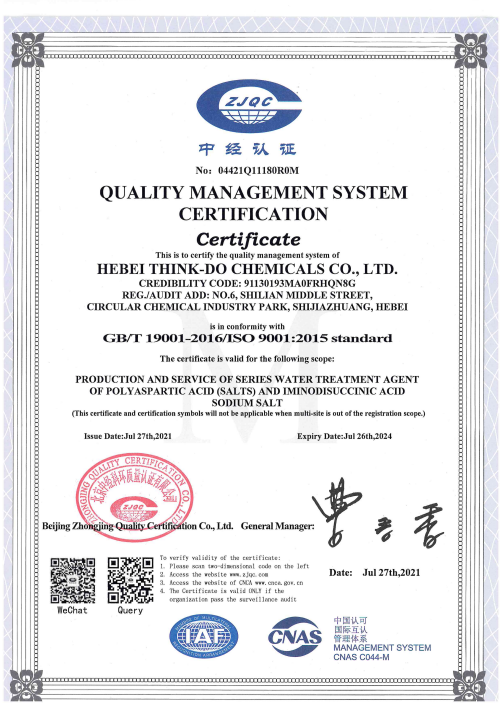
News
Dic . 03, 2024 11:57 Back to list
calcium chelating agent examples
Understanding Calcium Chelating Agents Examples and Applications
Calcium, an essential mineral in biological systems, plays a crucial role in various physiological functions. However, its presence can also lead to complications, particularly in industrial processes and formulations. To mitigate such issues, calcium chelating agents are employed. These agents have the ability to bind calcium ions, forming stable complexes that can prevent negative interactions with other components. This article will delve into the significance of calcium chelating agents, their examples, and their applications in various fields.
What are Chelating Agents?
Chelating agents, or chelators, are molecules that can form multiple bonds with a single metal ion, creating a chelate complex. This property is particularly useful for calcium since it tends to form insoluble salts in certain environments, potentially complicating processes in industries such as agriculture, pharmaceuticals, and food production. By using calcium chelating agents, industries can manage calcium levels effectively and enhance the performance of their products.
Examples of Calcium Chelating Agents
1. EDTA (Ethylenediaminetetraacetic Acid) EDTA is one of the most widely used chelating agents in various applications. Its ability to bind calcium and other metal ions makes it invaluable in both laboratory settings and industrial operations. In agriculture, EDTA is utilized to improve nutrient availability in soils, allowing plants to absorb essential minerals more efficiently. Additionally, in pharmaceuticals, it is used to treat heavy metal poisoning by sequestering toxic metals in the bloodstream.
2. Citric Acid Citric acid, a natural organic acid found in citrus fruits, serves as an effective calcium chelator. It forms soluble complexes with calcium ions, making it easier for the body to absorb calcium, which is crucial for bone health. In food products, citric acid is used not only as a preservative but also as a flavor enhancer. Its chelating properties help stabilize the color and taste of various food items.
3. Lactic Acid Another naturally occurring chelating agent is lactic acid, which is produced during fermentation processes. It has been recognized for its ability to bind calcium ions, which is particularly beneficial in dairy industries where calcium fortification is desired. In addition to food applications, lactic acid is also explored in pharmaceuticals and cosmetics for its skin-beneficial properties.
calcium chelating agent examples

4. Sodium Gluconate Sodium gluconate is a biodegradable chelating agent that finds extensive use in various sectors, including construction and water treatment. It effectively binds calcium and can help prevent the formation of scale in pipes and equipment. This quality not only improves equipment longevity but also enhances the overall efficiency of processes that involve water.
5. Tartaric Acid Tartaric acid, commonly used in the food and beverage industry, is another example of a calcium chelating agent. It helps stabilize certain products by sequestering calcium ions, preventing them from causing unwanted precipitation. Moreover, tartaric acid is essential in winemaking, where it aids in the clarification of wine and helps maintain its quality.
Applications of Calcium Chelating Agents
Calcium chelating agents are utilized across various fields due to their versatile nature. In agriculture, they play a vital role in nutrient delivery systems, ensuring that plants receive adequate calcium, which is essential for cellular structure and stability. In the food industry, these agents improve the quality and shelf life of products by preventing undesirable interactions between ingredients, such as calcium-induced cloudiness in beverages.
The pharmaceutical sector also benefits from calcium chelators, especially in formulations that require the controlled release of ingredients. By complexing calcium, these agents can enhance drug solubility and bioavailability, leading to improved therapeutic outcomes.
In the realm of environmental sciences, calcium chelating agents are employed in water treatment processes to prevent scaling in pipes and equipment, ensuring efficient operation. Additionally, they are used in cleaning agents to enhance the effectiveness of detergents by softening water, thereby allowing better performance of surfactants.
Conclusion
Calcium chelating agents are indispensable in various applications, providing practical solutions to challenges posed by calcium ions. With examples such as EDTA, citric acid, lactic acid, sodium gluconate, and tartaric acid, the significance of these agents spans agriculture, food production, pharmaceuticals, and environmental management. Their ability to form stable complexes with calcium not only enhances the quality and efficiency of products but also contributes to safer and more effective industrial practices. As research continues, the potential for new calcium chelating agents to emerge holds promise for further advancements in multiple fields.
-
Polyaspartic Acid Salts in Agricultural Fertilizers: A Sustainable Solution
NewsJul.21,2025
-
OEM Chelating Agent Preservative Supplier & Manufacturer High-Quality Customized Solutions
NewsJul.08,2025
-
OEM Potassium Chelating Agent Manufacturer - Custom Potassium Oxalate & Citrate Solutions
NewsJul.08,2025
-
OEM Pentasodium DTPA Chelating Agent Supplier & Manufacturer High Purity & Cost-Effective Solutions
NewsJul.08,2025
-
High-Efficiency Chelated Trace Elements Fertilizer Bulk Supplier & Manufacturer Quotes
NewsJul.07,2025
-
High Quality K Formation for a Chelating Agent – Reliable Manufacturer & Supplier
NewsJul.07,2025
